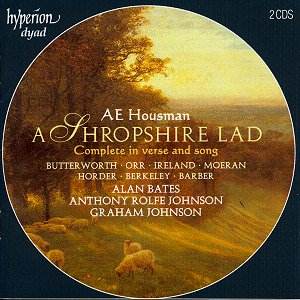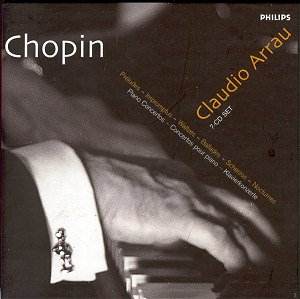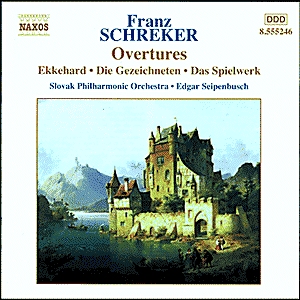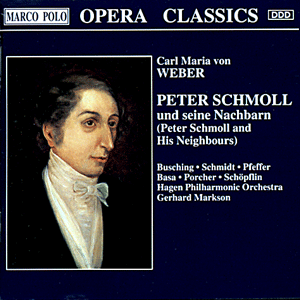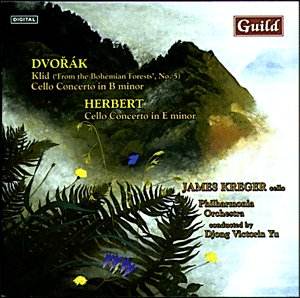 Composer: Antonín Dvořák (1841-1904), Victor Herbert (1859-1924)
Composer: Antonín Dvořák (1841-1904), Victor Herbert (1859-1924)
Works: Cello Concerto in B minor, Op. 104; Klid (Silent Woods); Cello Concerto No. 2 in E minor, Op. 30
Performers: James Kreger (cello), Philharmonia Orchestra/Djong Victorin Yu
Recording: Fairfield Hall, Croydon, London, 2001
Label: Guild GMCD 7235
The coupling of Dvořák’s Cello Concerto in B minor and Herbert’s Second Cello Concerto provides a compelling exploration of late Romantic cello repertoire, tethered by the shared influences of their compositional backgrounds. Dvořák, having been drawn to America’s vibrant cultural tapestry, infused his work with both nostalgia for his homeland and the new experiences of his time in New York. Herbert, who was steeped in the Germanic tradition and had intimate ties with Dvořák, crafted his concerto in a similar vein, albeit with a distinctly personal touch. This recording not only showcases the depth of the cello as a solo instrument but also illuminates the historical dialogue between these two composers.
James Kreger’s interpretation of Dvořák’s Cello Concerto is marked by a nuanced understanding of the score’s emotional undercurrents. The opening Adagio introduces a brooding theme that resonates with the listener, echoing the lament of the New World Symphony. Kreger’s execution here is particularly effective; his tone is rich and full-bodied, capturing the melancholy that pervades the work. The transition to the Allegro, with its martial rhythm, is executed with agility, though at times Kreger’s entry feels slightly tentative, lacking the confidence found in Julian Lloyd Webber’s notable recordings. However, Kreger compensates with emotional depth, particularly in the lyrical passages, where the interplay between cello and woodwinds becomes a poignant dialogue.
The recording quality is commendable, with the Philharmonia Orchestra’s lush textures providing a supportive backdrop for Kreger’s cello. The engineering ensures a balanced sound, allowing the cello’s voice to shine without overshadowing the orchestra. Nonetheless, some orchestral elements, particularly the first violins, could benefit from a more prominent placement in the mix, as their delicate counter-melodies are at times too subdued. The pizzicato passages, however, are strikingly clear, showcasing the orchestra’s precision and responsiveness under Djong Victorin Yu’s direction.
Herbert’s Second Cello Concerto, while less known, offers a fascinating contrast. The work’s dark, impetuous opening sets a tone that is both urgent and introspective. Kreger’s interpretation reveals his technical prowess as he navigates the intricate motifs with skill, although it is evident that Herbert’s thematic material does not possess the same depth as Dvořák’s. The Lento serves as a lyrical respite, played with tenderness that fully exploits the cello’s expressive capabilities. Kreger’s phrasing here is well-considered, drawing out the emotional weight of the melodies while remaining keenly aware of the orchestral support. The finale returns to a more vibrant tempo, yet Kreger’s choices often lead to a slower unfolding of thematic material compared to the more spirited interpretations offered by other cellists, such as Lloyd Webber.
This recording stands as a valuable addition to the catalog of both composers’ works, particularly for those interested in the historical connections between Dvořák and Herbert. Kreger’s performance, while not without its hesitations, offers a deeply felt interpretation that is enhanced by the attentive orchestral accompaniment. The sound engineering captures the richness of the cello, though some adjustments in orchestral positioning would have improved the overall balance. The notes accompanying the recording provide insightful context, enriching the listener’s understanding of the pieces’ backgrounds.
this exploration of Dvořák and Herbert’s cello concertos confirms the enduring appeal of these works while showcasing Kreger’s interpretative strengths and sensitivity. The recording merits attention not only for its performances but also for the historical resonance it illuminates between two significant figures of the late Romantic era.
